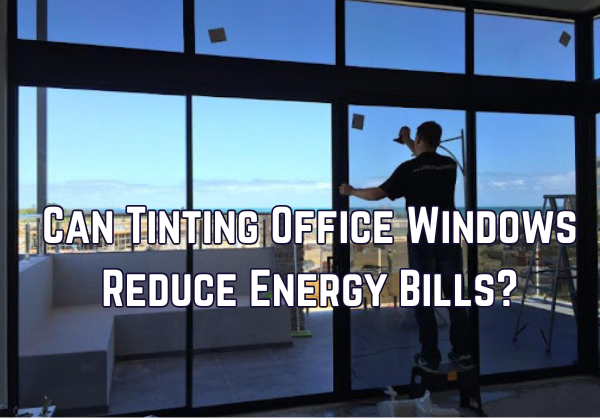If your office has large windows, you’ve likely felt the heat during sunny afternoons or noticed your AC working overtime.
Yes, Professional Commercial window tinting can reduce energy bills in commercial buildings, and it does more than just block sunlight.
In this post, we’ll explain how commercial window tinting works, how much energy it can save, and what type of film offers the best return on investment.
Key Takeaways
-
Window tint reduces energy use by blocking solar heat and improving HVAC efficiency.
-
Films can lower cooling costs by up to 15% or more, especially in sunny climates or buildings with lots of glass.
-
The best window films block infrared (IR) radiation, not just visible light.
-
Tinting is cheaper than window replacement, with quick payback and long-term ROI.
-
Energy-saving tints often include UV and glare protection as well.
What Causes High Energy Bills in Office Buildings?
Most commercial spaces with glass windows face the same issue:
Solar heat gain.
When sunlight hits unprotected glass, it passes infrared (IR) radiation and visible light into the building, warming up indoor spaces.
This forces your HVAC system to work harder, especially during the summer. Window film helps improve overall office comfort by reducing heat and glare.
| Factor | Impact on Energy Use |
|---|---|
| Direct sun exposure | Raise the indoor temperature |
| Poor insulation | Increases heat transfer |
| Overworked HVAC units | Higher electricity usage |
| Glare from sun | Leads to more blinds, less daylight use |
Glass is a weak insulator. Without a solar control solution, even double-pane glass can let in too much heat.
How Window Tinting Reduces Energy Bills
Blocks Solar Heat
Energy-saving films reject a large portion of solar energy, including:
-
Infrared rays (IR) – The main cause of heat
-
Visible light – In varying levels, depending on film type
-
UV rays – Not a heat factor, but damaging to interiors
Some commercial window films block up to 80% of solar heat.
This reduces the load on your air conditioning system, especially during peak hours.
Reduces HVAC Runtime
By keeping indoor temperatures cooler, window film reduces:
-
The need for frequent cooling cycles
-
HVAC energy demand during the hottest parts of the day
-
Wear and tear on heating and cooling equipment
According to the U.S. Department of Energy, window film can reduce energy usage by 5–15%, depending on building type and climate.
In warmer areas or buildings with west/south-facing windows, the savings can be even higher.
Cost vs. Savings: Is It Worth It?
Let’s break down a basic savings example.
| Office Size | 5,000 sq. ft. |
|---|---|
| Average Cooling Cost | $0.90/sq. ft. per year = $4,500/year |
| Estimated Savings | 10–15% = $450–$675 saved annually |
| Film Payback Period | 2–4 years (based on film and usage) |
For retail spaces, window tinting also boosts privacy and storefront appearance. With high-performance film, payback can be faster in sun-heavy regions, especially in buildings with large glass facades.
Types of Window Films That Help Reduce Energy Bills
Not all films offer the same performance. Here’s what to look for:
| Film Type | Solar Heat Rejection | Visibility | Use Case |
|---|---|---|---|
| Ceramic Window Film | High (50–80%) | Very clear | Offices needing clarity + heat control |
| Spectrally Selective Film | High (40–70%) | Very high | Buildings needing invisible energy savings |
| Reflective/Metallic Film | Very high (60–85%) | Tinted/mirrored | Best for large glass buildings or privacy |
| Dual-Reflective Film | High (50–80%) | Mildly tinted | Balances inside/outside visibility |
Other Energy-Saving Benefits
Reduces Interior Fading
Office furniture, carpets, and electronics fade with UV exposure.
Most energy-efficient films block up to 99.9% of UV rays, extending the life of your assets.
Reduces Glare and Improves Daylight Use
With less glare on monitors and screens, employees are more comfortable, and you can keep blinds open, using more natural daylight and reducing artificial lighting costs.
Maintains Comfort Across the Office
By minimizing heat near windows, you reduce hot and cold spots across rooms, which can help with HVAC zoning issues and improve worker satisfaction.
Bonus: Combine Film With Other Efficiency Improvements
Window film works even better when combined with:
-
Smart thermostats
-
Efficient HVAC zoning
-
LED lighting upgrades
-
Shading devices like overhangs or awnings
Energy audits often recommend window tinting as a first step, because it’s one of the most affordable upgrades.
Myth Busting: Does It Make Offices Too Dark?
No, energy-saving films come in a variety of light transmission levels.
You don’t need to darken your space to get heat control.
Many films are:
-
Clear or nearly invisible
-
Designed for high light transmission (50% to 70%)
-
Non-reflective from the inside, keeping natural views intact
Summary: Does Office Window Tinting Lower Energy Bills?
Yes, Tinting office windows is a proven way to reduce cooling costs, cut HVAC load, and improve indoor comfort. Understanding what to expect during installation helps you plan around your business schedule.
With the right film, you get:
-
Lower energy usage
-
Fewer hot zones
-
Better screen visibility
-
UV and glare protection
-
Long-term ROI
Most commercial buildings see measurable savings within the first 12–24 months, with benefits lasting over a decade.



